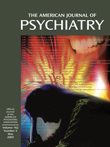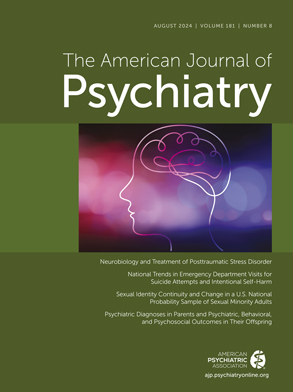To the Editor: This letter reports on olanzapine augmentation of fluoxetine in six patients with body dysmorphic disorder. Body dysmorphic disorder is a relatively common and severe disorder whose pharmacotherapy has been only minimally studied
(1). Body dysmorphic disorder appears to often respond to serotonin reuptake inhibitors (SRIs)
(1–
3), but most patients do not respond or respond only partially. Investigation of SRI augmentation strategies is therefore needed. Because 35%–50% of patients with body dysmorphic disorder are delusional
(1), SRI augmentation with antipsychotics is of particular interest.
An institutional review board approved this study, and the subjects provided written informed consent. Six subjects (50% women, mean age=29.3 years, SD=11.9) were first treated with fluoxetine for ≥12 weeks (mean dose=70.0 mg/day, SD=11.0). Olanzapine was then added to fluoxetine (the fluoxetine dose was unchanged) if the fluoxetine response was inadequate (i.e., the subjects still met DSM-IV body dysmorphic disorder criteria, had a body dysmorphic disorder score ≥20 on the Yale-Brown Obsessive Compulsive Scale Modified for Body Dysmorphic Disorder
(4), and were no more than minimally improved on the Clinical Global Impression scale [CGI]). Two subjects received olanzapine under double-blind conditions; four were treated openly with olanzapine after failing to respond to placebo. Exclusion criteria were standard for efficacy studies. The subjects took no other psychotropic medications. Olanzapine was begun at 2.5 mg/day, with an attempt to raise the dose to 15 mg/day over 8 weeks if it was tolerated.
With olanzapine treatment, body dysmorphic disorder symptoms on the CGI were minimally improved in two patients and unchanged in four. Olanzapine was received for a mean duration of 5.3 weeks (SD=3.1); the mean endpoint dose was 4.6 mg/day (SD=3.3). Two patients experienced fatigue, and three gained weight.
These results must be considered preliminary because of the small sample size. Nonetheless, they are consistent with the only placebo-controlled SRI augmentation study in body dysmorphic disorder, to my knowledge, in which a typical neuroleptic (pimozide) was not efficacious
(5). In what is to my knowledge the only report of SRI augmentation with atypical antipsychotics in body dysmorphic disorder (a chart review study, reference
3), only two of nine subjects responded, although the effect size was large. In one case report
(6), olanzapine monotherapy was efficacious. These somewhat mixed results underscore the need for further studies of atypical antipsychotics as augmentation agents and monotherapy. Because clinical experience suggests that atypical antipsychotics can be very helpful for associated anxiety and agitation, this also warrants investigation.

